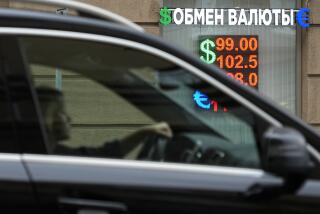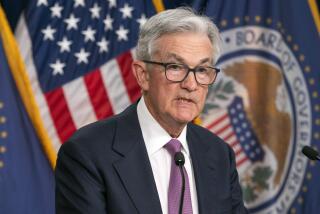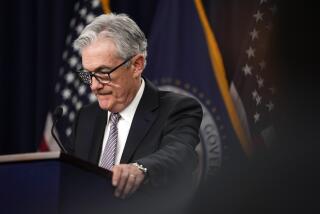Bundesbank Sets Pace : European Banks Lift Interest Rates to Aid Currencies
- Share via
BONN — Interest rates went up across Europe Thursday as nation after nation attempted to shore up their currencies against the dollar, which has been rising stubbornly for weeks despite efforts by U.S. and European central banks to bring it down.
West Germany, France and three other western European countries were responding to fears that a higher dollar would increase their domestic inflation rates and exacerbate current trade imbalances. Britain raised its key interest rate by a full percentage point after new figures showed its trade deficit reached a record high.
The dollar dropped sharply on international financial markets as Karl Otto Poehl, president of West Germany’s Bundesbank or central bank, said the bank’s governors “will do all we can” to prevent further depreciation of the mark. It closed lower against nearly all European currencies.
Pressure to Match Fed
Poehl made the unusually blunt statement at a news conference after announcing a half-point increase in West Germany’s discount rate to 3.5%. He also said the dollar recently had risen above ranges agreed to by members of the Group of Seven industrial nations, which set a framework for currency coordination in the Louvre Accord of February, 1987.
The Bundesbank raised the discount rate in part to help brake the dollar’s rise, which has threatened to add to West German inflation by raising the cost of imports, Poehl said.
The West Germans also felt pressure to match the Federal Reserve Board’s Aug. 9 increase of one-half percentage point in the U.S. discount rate to 6.5%, he said.
“The interest rate rise in the United States did not leave us unaffected,” Poehl said.
France, Switzerland, the Netherlands and Austria raised their interest rates largely in response to the Bundesbank’s action, analysts said.
Eighth Increase in Britain
The situation was different in Britain, which acted principally to slow a consumer spending boom that has contributed to record deficits in its foreign accounts.
The Bank of England raised its money market lending rate by a full percentage point, to 12%, after Britain announced that its current account deficit widened to a record 2.15 billion pounds, or $3.63 billion in July. It was the eighth interest rate increase in Britain in three months. British stocks fell sharply after the trade figures were released.
France’s 3-month-old Socialist government, yielding reluctantly to international pressure, raised two key short-term official interest rates by a quarter of a percentage point.
Finance Minister Pierre Beregovoy said that he “wanted the Bank of France’s interest rates adapted to the evolution of the international monetary situation.”
Several other central banks in Europe also raised their rates. The Bank of Italy raised its discount rate by half a percentage point to 12.5%, the first change since Aug. 28, 1987. The Dutch central bank--the Nederlandsche Bank--boosted its discount rate by one-quarter point to 4% from 3.75%. The Swiss National Bank raised its discount and Lombard interest rates a half point each to 3% and 5% respectively.
Japan, which also has been pressured by U.S. officials to raise its interest rates, declined. A senior bank of Japan official said in Tokyo there was “absolutely no need to consider an adjustment in Japan’s monetary policy just because the Bundesbank and the Bank of England raised their base rates.”
In Canada, meanwhile, the nation’s central bank increased its key lending rate to 10.03% from 9.8%, and commercial banks responded immediately by raising their prime rate one-half point, to 11.25%.
The U.S. Treasury Department had no comment on the increases in European interest rates, although the Reagan Administration and the Federal Reserve have been less secretive than usual in recent weeks about their efforts to drive down the dollar.
The interest rate increase in West Germany, Europe’s largest economy, risks dampening domestic growth here just when it was showing signs of picking up.
The government recently raised its prediction for 1988 economic growth to a range of between 2.5% and 3% after inflation, and Poehl predicted 3% growth for the year. Inflation is expected to be about 1%.
More to Read
Inside the business of entertainment
The Wide Shot brings you news, analysis and insights on everything from streaming wars to production — and what it all means for the future.
You may occasionally receive promotional content from the Los Angeles Times.










